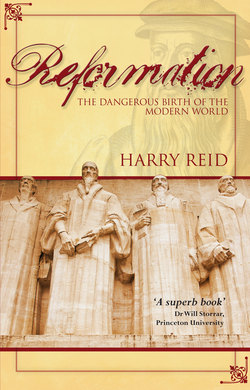Читать книгу Reformation - Harry Reid - Страница 13
На сайте Литреса книга снята с продажи.
ОглавлениеNote on Contexts and Terms
THIS book is a survey of the European Reformation of the sixteenth century and its consequences. It is not intended to be a complete history of the Reformation. What happened in countries like Norway, Sweden, Denmark, Poland, Ireland and Wales is barely touched on. The book deals mainly with Scotland, England, Germany, Switzerland, France and Italy, and to a much lesser extent Spain and its colonies in the Low Countries.
There is relatively little here about the threat of the Turks – a constant consideration for Western Europeans in that turbulent century. Suleiman the Magnificent was then the most powerful figure in the entire world, and it could be argued that the Turks saved the Reformation because the Holy Roman Emperor had to divert so much of his energy and effort to dealing with the threat from the East rather than with the Protestant revolt. And, if there is little about the Turks and the Muslim threat from the East, there is nothing at all in this book about the Eastern Orthodox Church.
Two very different places which are particularly important in our story are Wittenberg, the town in northern Germany which will always be associated with Luther, and Rome. Luther was a professor at Wittenberg’s new, and very small, university. It was then a minor town of between 2,000 and 3,000 people. Its main industry was the brewing of heavy beer, a product that Luther appreciated. Rome was, by contrast, a big and important city, more like Paris. It was teeming with life, a lot of it low, though it was not quite as decadent and dirty as Paris, which in the early sixteenth century was (in some ways literally) the cesspit of Europe.
Paris was the city, ironically, where the austere and prim young Calvin studied. It was a city famous throughout Europe for its prostitutes, who sometimes picked up their clients in Notre Dame Cathedral. Rome, too, had its prostitutes, its thieves and its gangsters; but two puritanical popes in the latter part of the sixteenth century did much to clean up the city. It had suffered a grievous shock to its self-esteem during the infamous Sack of 1527.
Much of the wonderful art which today adorns Rome is associated with the Counter-Reformation that began in earnest in the mid-sixteenth century. When the young monk Luther, very much a northern provincial, was sent to Rome in 1510, he travelled in high expectation but despaired of what he found: ignorance and immorality.
The word ‘Protestant’ dates from the second Diet of Speyer in 1529. But I use it in its general sense, meaning an adherent of reformed Christianity as opposed to an adherent of the Roman Church, which is also referred to as the old Church or the Catholic Church. I reckon it is reasonable to talk about Luther and his followers being Protestants in 1519, ten years before the term was actually coined.
The word ‘humanism’ is used, not in its contemporary sense but rather to describe the loose cerebral movement that straddled the late medieval period and the age of the Reformation. Humanists then were learned men who were critical of the state of the Church yet believed that reform and criticism should be restrained. They tended to be of sceptical, urbane disposition; the greatest humanist was Erasmus of Rotterdam. Such men were too sophisticated to go along with the crudity of a bludgeoning revolutionary like Luther.
‘Germany’ is used to describe what is more or less the Germany of today. In the sixteenth century, it was part of the Holy Roman Empire, ruled by an elected emperor. Shortly after Luther’s Reformation began, Charles V was elected emperor. He was an earnest and decent man who presided over the Diet of Worms in 1521, where Luther made his great stand. Under the Peace of Augsburg in 1555, the empire was formally divided between Roman Catholics and Lutherans.
Lutherans were, obviously enough, those Protestants who followed Luther. Later exponents of the reformed religion, such as Calvinists and Presbyterians, were generally known as belonging to the Reformed, as opposed to the Lutheran, Church. Protestantism had from the start a chronic fissile tendency.
‘Presbyterian’ describes a type of Reformed Church government that excludes bishops and emphasises the parity and equality of ministers. Knox’s Reformation in Scotland was not firmly Presbyterian; it became properly Presbyterian in its second phase, under Andrew Melville.
Finally, the word ‘Reformation’ is used as a catch-all term for the reforming movement that Luther started in northern Germany in 1517. There were many separate reformations. The term ‘Counter-Reformation’ is used in this book to describe the impressive Catholic fightback, which, while belated, was able to take advantage of the growing division in Protestant ranks. Some historians prefer the term ‘Catholic Reformation’.
